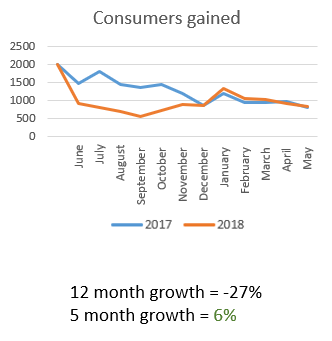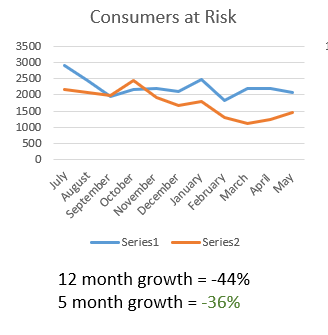-
7 Ecommerce Ecommerce KPIS your business should be tracking
11 Mar 2019 Dominic Comments Off on 7 Ecommerce Ecommerce KPIS your business should be tracking

In any ecommerce business, it is essential to know exactly which KPIs need to be tracked to ensure you are tracking your business growth against the budget you have allocated to the channel. This will enable you and your management team to easily see that the investment allocated to the channel is working and that a good ROI is being achieved. More than that, it lets you easily see if your business is growing and what issues you may have impacting that growth.
Different business will track different KPIs depending on the sector or the type of product being sold (eg in publishing, downloads may be one KPI you may want to track). For myself, I like to look at 7 basic KPIs for any business I work with – these are key KPIs that have worked for me over the years and are a good measure of how your business is trading.
1 – Consumers gained
The basic for any business – how many new customers are you recruiting? You need to be continually looking for new opportunities to recruit new consumers. Your marketing budget will have been agreed, signed off and your company will be expecting a return on this budget – so it is essential to be tracking all your new customers to an agreed CPA budget – once recruited you need to make sure they drop immediatley into an email welcome program to get that 2nd order!
Example = retailer is up 6% YOY – not bad but as you can see a massive drop over the 12 months but picked up over last 5 months trading.
2 – Returning customers
Are your customers still in love with your brand? If so, this metric should be stable or increasing as you both rccruit new customers and your marketing campiagns do more to prevent customers leaving you for competitors. Tracking returning customers will also give you a good idea if your buiness has any issues – notice a sudden dip in your numbers? Perhaps that delivery charge increase has had the knock on effect of losing you existin customer base?
Example – as you can see here, this retailer suffered a massive drop in returning customers which was specifically down to stock issues online and product availability
3 – Customers placing 2nd orders
Getting your customers to place that second order can sometimes be quite difficult depending on what you sell. After the first purchase has been made you need to enter into a relationship with your customers – keep them up to date and make sure its not all about sell sell sell!
Perhaps your company has a background story to tell or, if you are in retail, do you know that perfect “golden triangle” of products with which to cross sell or upsell?
Example = with this retailer, the challenge was to get the 2nd order rates positive. The problem here was many customers placing first order online but going into store for second orders.
4 – Customers at risk
So you are focusing on new customer acquisition and making sure that customers are coming back to place theeir second order – but what about those customers who have not shopped or come back for some time? These are the customers who fall into the “at risk” category.
Every retailer will have different rates of purchase – eg fast fashion retailers will probably see more frequent purchases than big ticket items. Once you have agreed your definition of “at risk”, start tacking these metrics and compare YOY. The intention is for this number to decrease over time as you do more to engage with your audience.
Example = here we can see high numbers of customers who were dropping into the “at risk” category however, after analysing the types of customers and different purchase behaviour, I applied a strategy to start improving (ie reducing) this number over time.
5 – Customers Lapsing
Every business has issues with lapsing customers – the key is to make sure once again you are doing you best to track lapsing customers and have a program in place to prevent them from lapsing. Make sure you know your customer segments well – some customers will lapse anyway (eg they only came in on that 30% sale) or perhaps they were part of a giveaway campaign?
Example = Numbers will obviously depend on activity you have run previously to drive sales – here you can see a huge spike in lapsing customers. This was actually a free giveaway which drive 10,000 new customers HOWEVER 88% of them never came back to place a 2nd order.
6 – Conversion Rate
Website conversion rate is one of the key metrics you need to be tracking regularly and is the basis for any Ecommerce business. Your digital marketing activity should be targetting qualified traffic to send to your website – the conversion rate is then the total amount of orders taken divided by that total traffic.
This may very wildly between different sectors – for example a typical fashion retail business I would expect to convert at between 4 – 5% however other businesses I have worked with (eg where product purchase is more loyal) have had much higher conversion rates as you can see here.
Example = this was a business which had a typically high conversion rate however suffered a lot of issues in the year previous with stock etc. This affected conversion rate as you can see however, with all issues fixed, conversion rate was improved significantly
7 – Traffic by Channel
This is a KPI not every business is too keen on tracking but I personally like to track it because, if set up correctly, it alllows you to review each channel independently and get a rough idea what is working and what is not. Plus it also allows you to plan out for growth. For larger companies with substantial website traffic this allows you to track the 3 main channels which will be driving your growth – direct traffic, organic traffic and email traffic.
Example – this business had been in decline for some years as you can see in the YOY stats. Regulatory changes affected how they could promote their products hence the decline in email traffic plus, with the brand in decline and little investment made over the years, the direct traffic had also been in decline. The one success story was Organic Search, where we could invest in drive significant increases in qualified traffic.
To summarise, every business needs to track key KPIs to make sure they are growing as a business and addressing issues where they have been identified. If you focus on these 7 KPIS, you should have a good solid understanding of how you are performing online.
I should note these KPIs are not exhaustive – others you may want to track to should include orders placed, units placed, AOVs – obviously revenue goes without saying!
Categories: Acquisition, Conversion, Planning, Small Business Blog, Trading Tips, Traffic, Why me?
Tags: Digital Marketing, KPIs, Trading Tips
Email automation driving incremental sales of 20% Website Trading – mistakes to avoid
Categories
- Acquisition (4)
- AI (2)
- All Posts (41)
- Data Science (1)
- Amazon (1)
- Analytics (6)
- Brand (9)
- Conversion (12)
- Customer Surveys (2)
- DXP (1)
- Email (4)
- Google (6)
- Mobile (2)
- Paid search (5)
- Planning (9)
- Platform (4)
- Presentations (2)
- Promotions (3)
- RAF (1)
- Retention (7)
- SEO (6)
- Site Search (1)
- Small Business Blog (3)
- Social Media (4)
- Strategy (9)
- Trading Tips (18)
- Traffic (5)
- Uncategorized (8)
- Why me? (6)







Comments are currently closed.